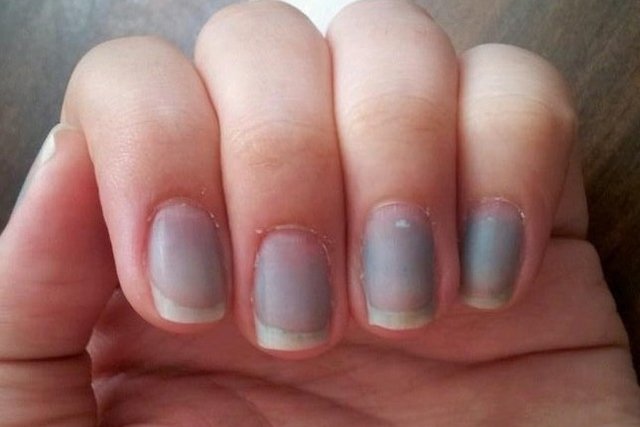Dark nails are usually caused by direct blows to the fingers, habits like biting or pulling out your nails, or using antifungal or chemotherapy medications. In some cases, dark nails may be a sign of a more serious condition, like a fungal infection or melanoma in the nail.
Initially, the appearance of black lines or dark spots on the fingernail or toenail may be noticed. This may be noted on one or more fingers, and can be by other symptoms such as pain, swelling or nail deformities.
If you notice dark nails, especially if the darkening of the nail gradually worsens or does not improve, it is important to consult a dermatologist, who can help to identify a cause and start treatment. Treatment may involve measures such as avoiding biting your nails or wearing tight shoes, using antifungal medications and, in some cases, surgery.

What causes dark nails?
The main causes of black nails are:
1. Direct trauma
A blow to the nail can lead to bruising, which can turn the nail black, brown or dark. The darkening in this case is related to the rupture of small blood vessels, causing blood to become trapped under the nail.
Typically, the bruise forms shortly after the blow and other symptoms may emerge, such as pain or swelling in the finger. You may also notice that the bruise changes position as the nail grows.
What to do: a bruise on the nail does not always require specific treatment. The trapped blood tends to come out from under the nail in a few weeks as the nail grows.
However, in case of pain or large bruises, the doctor may recommend the use of analgesic medications and drainage of trapped blood to relieve symptoms.
2. Biting or pulling your nails
A dark nail caused by biting or picking off pieces of nail can initially be identified by a black spot or line under the nail. Typically, this spot or line does not increase in size over time nor does it cause other symptoms.
What to do: In this case, targeted treatment is not required. You are advised to avoid these habits to prevent worsening. Check-out some tips on how to stop biting your nails.
It is still important to consult a dermatologist to confirm a diagnosis, and to monitor the dark nails, especially of there is a risk for melanoma.
3. Wearing tight shoes or gloves
Wearing tight shoes or gloves can damage the nails, causing the appearance of dark nails. These can initially be noticed by the darkening of the nail and the appearance of black spots or lines.
What to do: Dark toenails caused by wearing tight shoes or dark fingernails from tight gloves do not require specific treatment. Ideally, you should opt for looser shoes and gloves.
It is also important to consult a dermatologist to confirm the diagnosis. If there is a risk for developing melanoma, regular monitoring may be indicated.
4. Medication use
The use of some medications, especially antifungals and chemotherapy drugs, can cause the appearance of dark spots and lines on the nail, which can affect more than one finger and/or toe.
What to do: Dark nails caused by medications usually improve on their own about 6 to 8 weeks after the end of treatment. However, sometimes it may take a few months or years for the nail to return to normal.
5. Nail fungus
A fungal infection in the nail can cause darkening on the nail or lead to the appearance of dark spots. Fungal injections will typically affect more than one nails, and cause deformities and thickening. Learn more about nail fungus and the symptoms associated with it.
What to do: If you suspect you may have nail fungus, it is important to consult a dermatologist to confirm a diagnosis. Treatment usually involves the use of antifungal medications in tablet form, or topical antifungals applied directly to the affected nails.
6. Melanoma on the nail
Melanoma on the nail is characterized by the appearance of a dark brown or black spot, which is most common on the index finger, thumb or big toe. The darkening tends to increase in size over time, and can potentially turn the nail black.
What to do: if melanoma is suspected on the nail, it is important to consult a dermatologist. The doctor may order a biopsy to confirm the diagnosis. Treatment for nail melanoma usually involves surgical removal of the malignant tissues.
